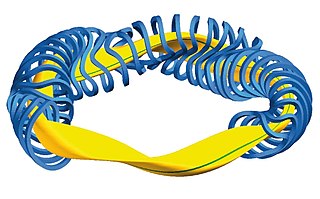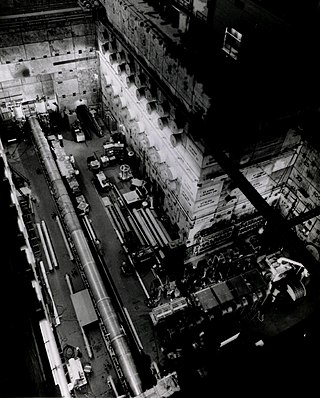Related Research Articles

A stellarator confines plasma using external magnets. Scientists aim to use stellarators to generate fusion power. It is one of many types of magnetic confinement fusion devices, most commonly tokamak. The name "stellarator" refers to stars because fusion mostly occurs in stars such as the Sun. It is one of the earliest human-designed fusion power devices.

A tokamak is a device which uses a powerful magnetic field generated by external magnets to confine plasma in the shape of an axially symmetrical torus. The tokamak is one of several types of magnetic confinement devices being developed to produce controlled thermonuclear fusion power. The tokamak concept is currently one of the leading candidates for a practical fusion reactor.

Princeton Plasma Physics Laboratory (PPPL) is a United States Department of Energy national laboratory for plasma physics and nuclear fusion science. Its primary mission is research into and development of fusion as an energy source. It is known for the development of the stellarator and tokamak designs, along with numerous fundamental advances in plasma physics and the exploration of many other plasma confinement concepts.
This timeline of nuclear fusion is an incomplete chronological summary of significant events in the study and use of nuclear fusion.

James Leslie Tuck was a British physicist, working on the applications of explosives as part of the British delegation to Manhattan Project.

The Huemul Project was an early 1950s Argentine effort to develop a fusion power device known as the Thermotron. The concept was invented by Austrian scientist Ronald Richter, who claimed to have a design that would produce effectively unlimited power.

Magnetic confinement fusion (MCF) is an approach to generate thermonuclear fusion power that uses magnetic fields to confine fusion fuel in the form of a plasma. Magnetic confinement is one of two major branches of controlled fusion research, along with inertial confinement fusion.

ZETA, short for Zero Energy Thermonuclear Assembly, was a major experiment in the early history of fusion power research. Based on the pinch plasma confinement technique, and built at the Atomic Energy Research Establishment in the United Kingdom, ZETA was larger and more powerful than any fusion machine in the world at that time. Its goal was to produce large numbers of fusion reactions, although it was not large enough to produce net energy.

Amasa Stone Bishop was an American nuclear physicist specializing in fusion physics. He received his B.S. in physics from the California Institute of Technology in 1943. From 1943 to 1946 he was a member of the staff of Radiation Laboratory at the Massachusetts Institute of Technology, where he was involved with radar research and development. Later, he became a staff member of the University of California at Berkeley from 1946 to 1950. Specializing in high energy particle work, he earned his Ph.D. in physics in 1950.
The Perhapsatron was an early fusion power device based on the pinch concept in the 1950s. Conceived by James (Jim) Tuck while working at Los Alamos National Laboratory (LANL), he whimsically named the device on the chance that it might be able to create fusion reactions.
Sceptre was a series of early fusion power devices based on the Z-pinch concept of plasma confinement, built in the UK starting in 1956. They were the ultimate versions of a series of devices tracing their history to the original pinch machines, built at Imperial College London by Cousins and Ware in 1947. When the UK's fusion work was classified in 1950, Ware's team was moved to the Associated Electrical Industries (AEI) labs at Aldermaston. The team worked on the problems associated with using metal tubes with high voltages, in support of the efforts at Harwell. When Harwell's ZETA machine apparently produced fusion, AEI quickly built a smaller machine, Sceptre, to test their results. Sceptre also produced neutrons, apparently confirming the ZETA experiment. It was later found that the neutrons were spurious, and UK work on Z-pinch ended in the early 1960s.

The Astron is a type of fusion power device pioneered by Nicholas Christofilos and built at the Lawrence Livermore National Laboratory during the 1960s and 70s. Astron used a unique confinement system that avoided several of the problems found in contemporary designs like the stellarator and magnetic mirror. Development was greatly slowed by a series of changes to the design that were made with limited oversight, leading to a review committee being set up to oversee further development. The Astron was unable to meet the performance goals set for it by the committee; funding was cancelled in 1972 and development wound down in 1973. Work on similar designs appears to have demonstrated a theoretical problem in the very design that suggests it could never be used for practical generation.
The biconic cusp, also known as the picket fence reactor, was one of the earliest suggestions for plasma confinement in a fusion reactor. It consists of two parallel electromagnets with the current running in opposite directions, creating oppositely directed magnetic fields. The two fields interact to form a "null area" between them where the fusion fuel can be trapped.

Stephen O. Dean is an American physicist, engineer and author. He was born in Niagara Falls, New York, United States, and grew up there through high school.

The Princeton Large Torus, was an early tokamak built at the Princeton Plasma Physics Laboratory (PPPL). It was one of the first large scale tokamak machines and among the most powerful in terms of current and magnetic fields. Originally built to demonstrate that larger devices would have better confinement times, it was later modified to perform heating of the plasma fuel, a requirement of any practical fusion power device.
The Sherwood Conferences were a series of classified conferences that were held between 1952 and 1958 in the United States. These conferences were a part of the United States controlled nuclear program called Project Sherwood. These conferences were established in order to entice experienced personnel to join the newly developed Project Sherwood. There were three different plasma confinement designs that were being researched in three different locations: the stellarator at Princeton Plasma Physics Laboratory, the toroidal pinch at Los Alamos National Laboratory, and the magnetic mirror at the Livermore National Laboratory. Because these individual projects operated in separate facilities, these conferences were helpful to strengthen communication of information between all three projects.

Natan Aronovich Yavlinsky was a Russian physicist in the former Soviet Union who invented and developed the first working tokamak.
The history of nuclear fusion began early in the 20th century as an inquiry into how stars powered themselves and expanded to incorporate a broad inquiry into the nature of matter and energy, as potential applications expanded to include warfare, energy production and rocket propulsion.

Theta-pinch, or θ-pinch, is a type of fusion power reactor design. The name refers to the configuration of currents used to confine the plasma fuel in the reactor, arranged to run around a cylinder in the direction normally denoted as theta in polar coordinate diagrams. The name was chosen to differentiate it from machines based on the pinch effect that arranged their currents running down the centre of the cylinder; these became known as z-pinch machines, referring to the Z-axis in cartesian coordinates.
The toroidal solenoid was an early 1946 design for a fusion power device designed by George Paget Thomson and Moses Blackman of Imperial College London. It proposed to confine a deuterium fuel plasma to a toroidal (donut-shaped) chamber using magnets, and then heating it to fusion temperatures using radio frequency energy in the fashion of a microwave oven. It is notable for being the first such design to be patented, filing a secret patent on 8 May 1946 and receiving it in 1948.
References
- ↑ Bromberg, Joan Lisa (1982) Fusion: Science, Politics, and the Invention of a New Energy Source MIT Press, Cambridge, Massachusetts, p. 44, ISBN 0-262-02180-3
- ↑ "Project Sherwood and the origin of the annual Sherwood Fusion Theory Conference". Sherwood Fusion History.
- ↑ Bromberg, p. 47
- 1 2 3 4 5 6 7 8 Clery, Daniel (2014). A Piece of the Sun: The Quest for Fusion Energy. The Overlook Press. ISBN 978-1468308891.
- ↑ Pfau, p. 209
- ↑ Bishop, Amasa (1958). Project Sherwood; the U.S. Program in Controlled Fusion . Addison-Wesley. p. 156. ISBN 9781258905354.
- ↑ Bishop, Amasa (1958). Project Sherwood; the U.S. Program in Controlled Fusion . Addison-Wesley. p. 154. ISBN 9781258905354.
- ↑ Bishop, Amasa (1958). Project Sherwood; the U.S. Program in Controlled Fusion . Addison-Wesley. p. 155. ISBN 9781258905354.
- 1 2 Bromberg, Joan Lisa (1985). Fusion: Science, Politics, and the Invention of a New Energy Source. The MIT Press. p. 96. ISBN 9780262521062.
- ↑ Bishop, Amasa (1958). Project Sherwood; the U.S. Program in Controlled Fusion . Addison-Wesley. p. 160. ISBN 9781258905354.
- ↑ Bishop, Amasa (1958). Project Sherwood; the U.S. Program in Controlled Fusion . Addison-Wesley. p. 65. ISBN 9780201005752.
- ↑ Bishop, Amasa (1958). Project Sherwood; the U.S. Program in Controlled Fusion . Addison-Wesley. p. 68. ISBN 9780201005752.
- ↑ Bishop, Amasa (1958). Project Sherwood; the U.S. Program in Controlled Fusion . Addison-Wesley. pp. 70–72. ISBN 9780201005752.
- ↑ Bishop, Amasa (1958). Project Sherwood; the U.S. Program in Controlled Fusion . Addison-Wesley. p. 72. ISBN 9780201005752.
- 1 2 3 4 5 Bishop, Amasa (1958). Project Sherwood; the U.S. Program in Controlled Fusion . Addison-Wesley. p. 152. ISBN 9780201005752.
- ↑ Bromberg, Joan Lisa (1985). Fusion: Science, Politics, and the Invention of a New Energy Source. The MIT Press. p. 97. ISBN 9780262521062.